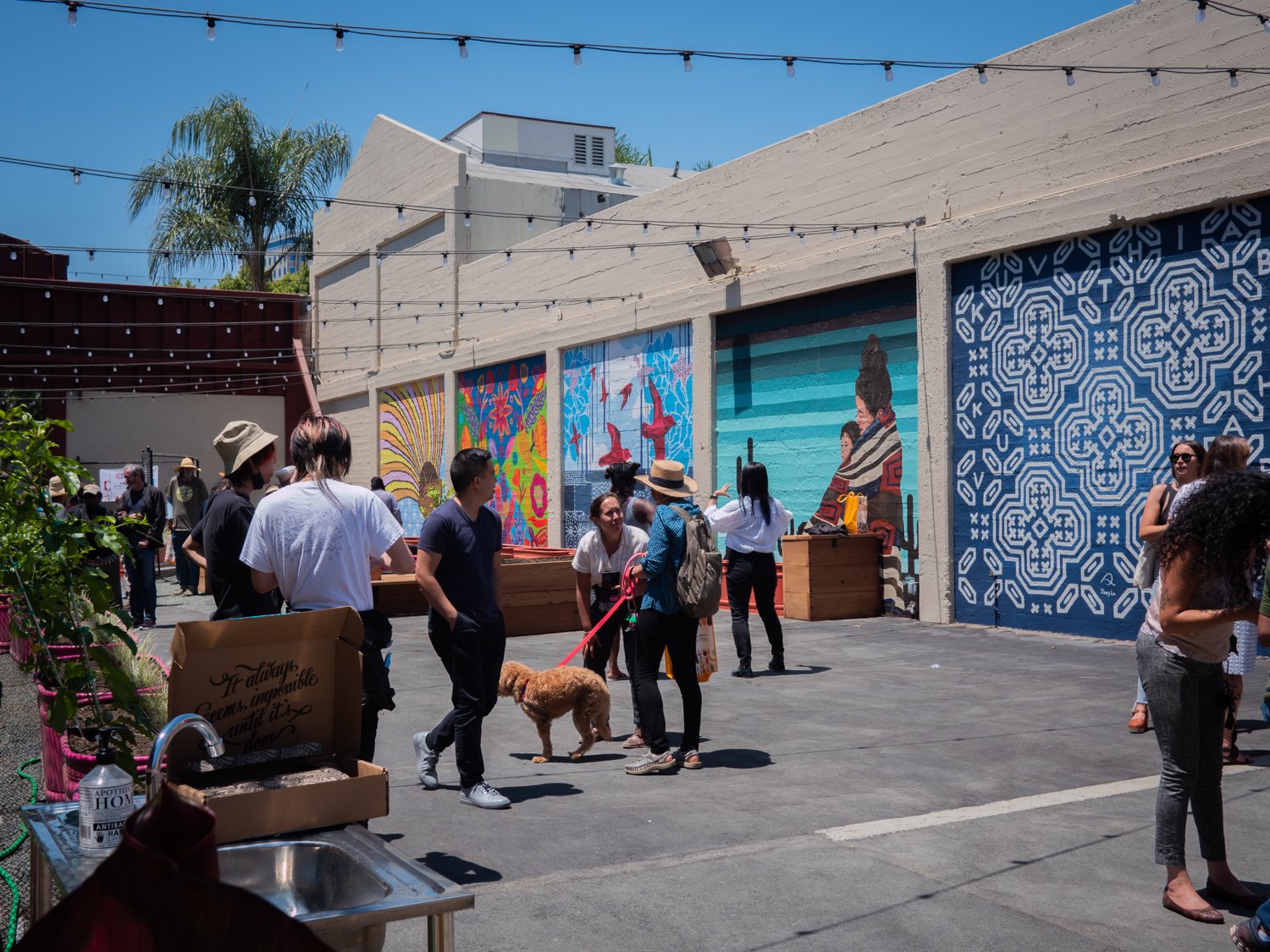SoFA Pocket Park Textile Inspired Murals
In February 2021, A Bay Area-wide call asked artists to create mural designs inspired by their culture’s textile traditions. These eight artists, of over 50 submissions, were selected: Paige Mason, Yoland Guerra, Maylea Saito, John Barrick, Sheng Lor, SIDY, Evelyn Salguero, and Ryan Carrington.
8 murals were created representing textiles from various cultures including African, Mexican, Japanese, Navajo, Hmong, Chinese, Guatemalan, and American.
Why is Public Art Important?
Video by: Andrew Sumner
“Braided Full of Sunshine” By Paige Mason
Pairing the beautiful aesthetics and patterning of traditional African textiles with the intricacies of braided hair, Paige stays true to her subject matter by featuring a young black girl. Her hair is in mid-flip, creating a ray of joyous patterning and vibrant colors, translating wealth, growth, and royalty.
“One Thousand Generations” By Maylea Saito
This mural illustrates an exploration of mixed cultural identity through traditional Japanese textile elements. Maylea was inspired by the boro patchwork method, where worn fabrics are pieced together and reinforced by sashiko embroidery to make new garments. For the artist, boro reminds her of how one's character can be influenced by a rich tapestry of experiences woven together, either in one's own lifetime or passed down through generations. As a third-generation Japanese American, she is continuously discovering the patches and patterns that make up her own identity. The flock of Chidori birds surrounded by iconic floral motifs symbolizes empowerment and liberation through the journey of learning about one's own history. In Japanese, the Chidori's chirp is a homonym for "Chiyo", meaning "one thousand generations".
“Coins at Crossroads, Cucumber Seeds, Me Too” By Sheng Lor
Textile Artist Sheng Lor is inspired by Hmong textiles. This creation imagines the stories we might learn if the symbols which Hmong women drew in wax to make batik cloths were discerned as a written language. This textile story depicts coins (women) at crossroads, cucumber seeds (hope), and the text “kuv thiab,” which means, “me too,”. The mural honors the women who carried the symbols in their clothing as a rebellion, women who narrated cultural and social values through textiles, women who continued to labor even in the face of crisis, displacement, and loss, and women whose stories and moments have yet to be told.
“El Portal del Regreso” By Evelyn Salguero
Using a red-toned Guatemalan Hupil as the backdrop for this piece, its color is used to honor and praise the Indigenous Mayan people that succumbed to genocide during the Guatemalan war. At the forefront of the artwork is a hybridized plant form, dancing to the rhythm of the patterns that encompass it. Its placement, representative of an irrepressible spirit that rises and grows through adversity using complementary colors and unity in movement, also seen in nature as catalysts.
“Huipil of Love and Home” By Yoland Guerra
Inspired by embroidered huipils found in Mexico and throughout South America, Yolanda incorporates California and Ohlone iconographies such as quail, poppies, lupines, beads, and shells. The colors used reflect the carmine colors derived from the cochineal insect that thrives on the cacti found in these southern regions. This natural dye originated with the indigenous people of Oaxaca, Mexico, and the vibrant colors are an expressive life force of culture.
“Future Leader” By John Barrick
The image of a Southwest sunrise, with a Mother and her child wrapped in a Navajo second phase Chief’s blanket, represents the nurturing of the next generation of leaders. The background is a traditional serape style pattern with silhouettes of a Southwest desert landscape.
“Auspicious Dragon” By Sidy
This mural is based on the Four Chinese Auspicious Beasts and the Yellow Dragon. The dragon’s head is made up of the four auspicious beings-- the Black Tortoise, White Tiger, Vermillion Phoenix, and Azure Dragon. These beings represent Yin and Yang, Seasons, Earth elements, and the four directions. The Dragon’s face is made up of smaller beings, representing the connections of the seasons and elements to the Earth. Although each beast has its own symbolic color I felt it would take away from the form of the dragon's face. The border pattern is made up of Four Chinese symbols commonly found in Chinese art. These ornate characters are prosperity, luck, longevity, and double happiness.
“Gingham” By Ryan Carrington
The classic gingham plaid tablecloth pattern is considered to be one of the most nostalgic patterns of American culture. Growing up in the Midwest, the checkerboard red and white pattern was associated with the smell of grilling meat, fresh fruits and vegetables, and being together with family. The backdrop of these iconic scenes was an ideology that promised the American Dream, and the false narrative that this dream was equally available to everyone.
Photography by Andrew Sumner










